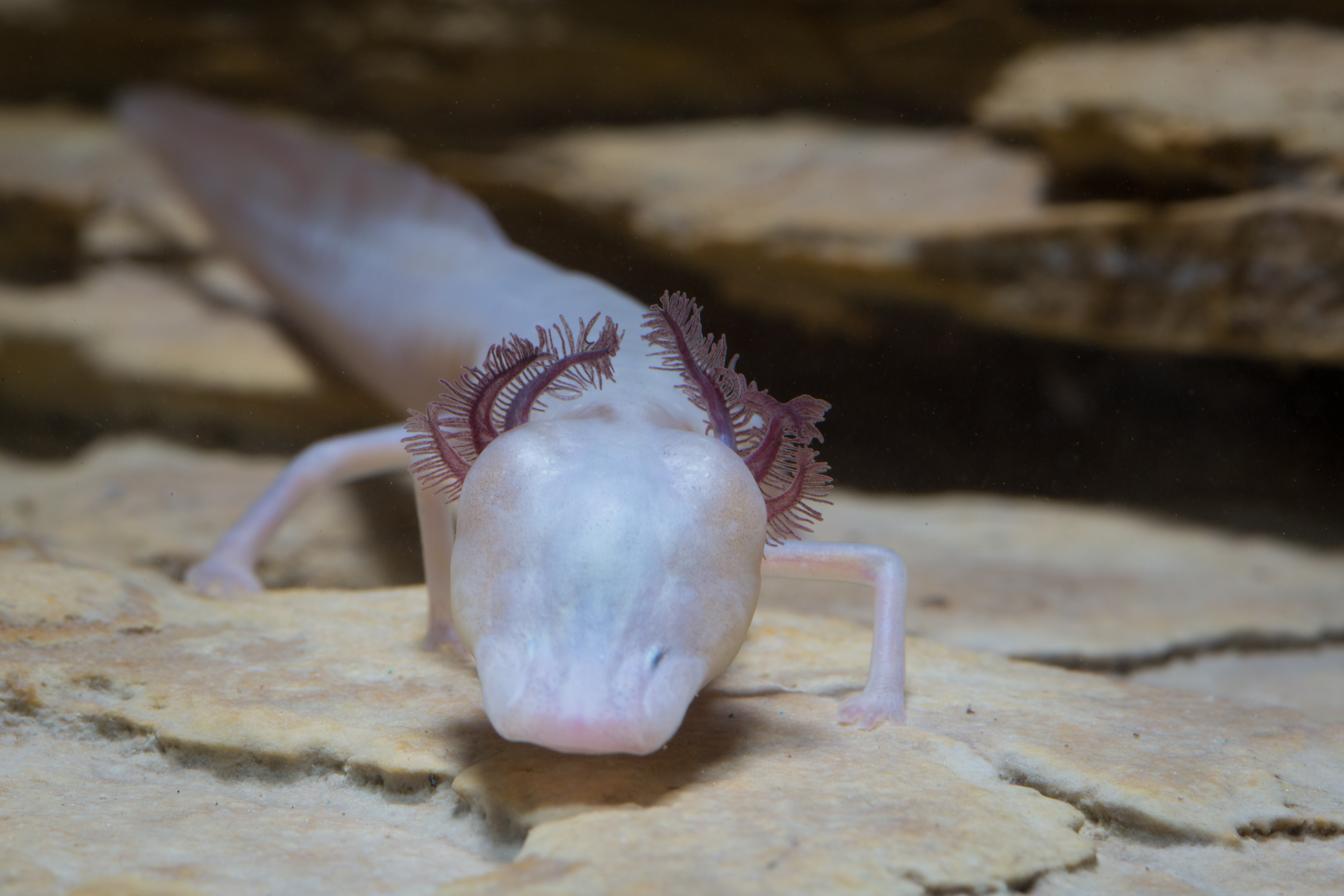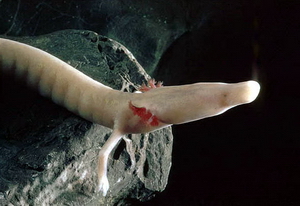|
Texas Blind Salamander
The Texas blind salamander (''Eurycea rathbuni'') is a rare and endangered cave-dwelling troglobite amphibian native to San Marcos, Hays County, Texas, specifically the San Marcos Pool of the Edwards Aquifer. This species resembles the olm, another stygofaunal salamander from Europe. Unlike the olm, this amphibian's body is not as elongated, and also has less reduced digits on its limbs (the olm only has three digits on its front limbs, and two on the back). Description The species has a broad, flat snout and head, and vestigial eyes beneath that are covered by skin. Like other neotenous salamanders, it has external gills for absorbing oxygen from the water. The salamander's mature length is around . The forelimbs carry four digits and the hind limbs possess five digits. The species is found to be able to regenerate its tail and limbs if they are lost. Its diet varies by what flows into its cave, and includes blind shrimp (''Palaemonetes antrorum''), snails, and amphipods. ... [...More Info...] [...Related Items...] OR: [Wikipedia] [Google] [Baidu] |
Edwards Aquifer
The Edwards Aquifer is one of the most prolific artesian aquifers in the world. Located on the eastern edge of the Edwards Plateau in the U.S. state of Texas, it is the source of drinking water for two million people, and is the primary water supply for agriculture and industry in the aquifer's region. Additionally, the Edwards Aquifer feeds the Comal River, Comal and San Marcos Springs, provides springflow for recreational and downstream uses in the Nueces River, Nueces, San Antonio River, San Antonio, Guadalupe River (Texas), Guadalupe, and San Marcos River, San Marcos river basins, and is home to several unique and endangered species. Basin characteristics Geography Located in South Central Texas, the Edwards Aquifer encompasses an area of approximately that extends into parts of 11 counties. The aquifer's boundaries begin at the groundwater divide in Kinney County, East of Brackettville, and extend Eastward through the San Antonio area and then Northeast where the aquif ... [...More Info...] [...Related Items...] OR: [Wikipedia] [Google] [Baidu] |
Leonhard Hess Stejneger
Leonhard Hess Stejneger (30 October 1851 – 28 February 1943) was a Norwegian-born American ornithologist, herpetologist and zoologist. Stejneger specialized in vertebrate natural history studies. He gained his greatest reputation with reptiles and amphibians. Wetmore, Alexander (1945). "Leonhard Hess Stejneger (1851–1943)". ''Biographical Memoir. Nat. Acad. Sci.'' 24: 145–195PDF/ref> Early life and family Stejneger was born in Bergen, Norway. His father was Peter Stamer Steineger, a merchant and auditor; his mother was Ingeborg Catharine (née Hess). Leonhard was the eldest of seven children. His sister Agnes Steineger was a Norwegian artist. Until 1880, the Steineger family had been one of the wealthy families in Bergen; at that time business reverses led to the father declaring bankruptcy. Stejneger attended the Smith Theological School in Bergen from 1859 to 1860, and Bergen Latin School until 1869. His interests in zoology developed early. By age sixteen, he had ... [...More Info...] [...Related Items...] OR: [Wikipedia] [Google] [Baidu] |
Amphibians Of The United States
Amphibians are ectothermic, anamniote, anamniotic, tetrapod, four-limbed vertebrate animals that constitute the class (biology), class Amphibia. In its broadest sense, it is a paraphyletic group encompassing all Tetrapod, tetrapods, but excluding the amniotes (tetrapods with an amniotic membrane, such as modern reptiles, birds and mammals). All extant taxon, extant (living) amphibians belong to the monophyletic subclass (biology), subclass Lissamphibia, with three living order (biology), orders: Anura (frogs and toads), Urodela (salamanders), and Gymnophiona (caecilians). Evolved to be mostly semiaquatic, amphibians have adapted to inhabit a wide variety of habitats, with most species living in freshwater ecosystem, freshwater, wetland or terrestrial ecosystems (such as riparian woodland, fossorial and even arboreal habitats). Their biological life cycle, life cycle typically starts out as aquatic animal, aquatic larvae with gills known as tadpoles, but some species have devel ... [...More Info...] [...Related Items...] OR: [Wikipedia] [Google] [Baidu] |
Cave Salamanders
A cave salamander is a type of salamander that primarily or exclusively inhabits caves, a group that includes several species. Some of these animals have developed special, even extreme, adaptations to their subterranean environments. Some species have only rudimentary (or even absent) eyes (''blind salamanders''). Others lack pigmentation, rendering them a pale yellowish or pinkish color (e.g., '' Eurycea rathbuni''). With the notable exception of the olm (''Proteus anguinus''), all "cave salamanders" are members of the family Plethodontidae ("lungless salamanders"). Almost all of them are paedomorphic and therefore never undergo metamorphosis, but it is not clear if this happened before or after they adapted to an existence in caves, as some species that don't live in caves are also paedomorphic. History The first dedicated scientific study of a cave animal was focused upon a cave salamander, '' Proteus anguinus''. It was originally identified as a "dragon's larva" by Johann ... [...More Info...] [...Related Items...] OR: [Wikipedia] [Google] [Baidu] |
Blanco Blind Salamander
The Blanco blind salamander (''Eurycea robusta'') is a species of aquatic, lungless salamander native to the United States. It is endemic to a small region of the Blanco River near San Marcos in Hays County, Texas. Its habitat, deep in limestone karst, makes collecting specimens for research particularly problematic. It is known from only a single specimen, collected in the 1950s. The Blanco blind salamander is considered a lost species with it being on Re:wilds Search For Lost Species initiative, as it is unknown whether it is still alive or not. Four specimens were discovered in 1951 by a gravel company digging in the dry bed of the Blanco River. Two were eaten by a heron, one was lost and the final specimen was sent to the University of Texas at Austin for research. Any extant members of the species are believed to live in the Edwards Aquifer. Researchers are using environmental DNA analysis to assess whether it still lives, but are hampered by the fact that no extant viable ... [...More Info...] [...Related Items...] OR: [Wikipedia] [Google] [Baidu] |
Axolotl
The axolotl (; from ) (''Ambystoma mexicanum'') is a neoteny, paedomorphic salamander, one that Sexual maturity, matures without undergoing metamorphosis into the terrestrial adult form; adults remain Aquatic animal, fully aquatic with obvious external gills. This trait is somewhat unusual among amphibians, though this trait is not unique to axolotls, and this is apparent as they may be confused with the Tadpole, larval stage or Ambystoma#Species, other neotenic adult mole salamanders (''Ambystoma spp.''), such as the occasionally paedomorphic tiger salamander (''Ambystoma tigrinum, A. tigrinum'') widespread in North America; or with mudpuppies (''Necturus spp.''), which bear a superficial resemblance but are from a different Family (biology), family of salamanders. Axolotls originally inhabited a system of interconnected wetlands and lakes in the Mexican highlands; they were known to inhabit the smaller lakes of Lake Xochimilco, Xochimilco and Lake Chalco, Chalco, and are al ... [...More Info...] [...Related Items...] OR: [Wikipedia] [Google] [Baidu] |
Climate Change
Present-day climate change includes both global warming—the ongoing increase in Global surface temperature, global average temperature—and its wider effects on Earth's climate system. Climate variability and change, Climate change in a broader sense also includes previous long-term changes to Earth's climate. The current rise in global temperatures is Scientific consensus on climate change, driven by human activities, especially fossil fuel burning since the Industrial Revolution. Fossil fuel use, Deforestation and climate change, deforestation, and some Greenhouse gas emissions from agriculture, agricultural and Environmental impact of concrete, industrial practices release greenhouse gases. These gases greenhouse effect, absorb some of the heat that the Earth Thermal radiation, radiates after it warms from sunlight, warming the lower atmosphere. Carbon dioxide, the primary gas driving global warming, Carbon dioxide in Earth's atmosphere, has increased in concentratio ... [...More Info...] [...Related Items...] OR: [Wikipedia] [Google] [Baidu] |
San Marcos River
The San Marcos River rises from the San Marcos Springs, the location of the Meadows Center for Water and the Environment (formerly Aquarena Springs), in San Marcos, Texas. The springs are home to several threatened or endangered species, including the Texas blind salamander, fountain darter, and Texas wild rice. The river is a popular recreational area, and is frequented for tubing, canoeing, swimming, and fishing. Course The river begins at San Marcos Springs, rising from the Edwards Aquifer into Spring Lake. Access to much of the headwaters is restricted because of the delicate ecosystem and numerous rare species. The upper river flows through San Marcos, and is a popular recreational area. It is joined by the Blanco River after four miles, and passes through Luling and Palmetto State Park. Near Gonzales, it flows into the Guadalupe River after a total of 75 miles (121 km). This course is the first section of the Texas Water Safari. History The histor ... [...More Info...] [...Related Items...] OR: [Wikipedia] [Google] [Baidu] |
Cloaca
A cloaca ( ), : cloacae ( or ), or vent, is the rear orifice that serves as the only opening for the digestive (rectum), reproductive, and urinary tracts (if present) of many vertebrate animals. All amphibians, reptiles, birds, cartilaginous fish and a few mammals ( monotremes, afrosoricids, and marsupial moles, etc.) have this orifice, from which they excrete both urine and feces; this is in contrast to most placental mammals, which have separate orifices for evacuation and reproduction. Excretory openings with analogous purpose in some invertebrates are also sometimes called cloacae. Mating through the cloaca is called cloacal copulation and cloacal kissing. The cloacal region is also often associated with a secretory organ, the cloacal gland, which has been implicated in the scent-marking behavior of some reptiles, marsupials, amphibians, and monotremes. Etymology The word is from the Latin verb ''cluo'', "(I) cleanse", thus the noun ''cloaca'', " sewer, drain" ... [...More Info...] [...Related Items...] OR: [Wikipedia] [Google] [Baidu] |
Dorsum (anatomy)
Standard anatomical terms of location are used to describe unambiguously the anatomy of humans and other animals. The terms, typically derived from Latin or Greek roots, describe something in its standard anatomical position. This position provides a definition of what is at the front ("anterior"), behind ("posterior") and so on. As part of defining and describing terms, the body is described through the use of anatomical planes and axes. The meaning of terms that are used can change depending on whether a vertebrate is a biped or a quadruped, due to the difference in the neuraxis, or if an invertebrate is a non-bilaterian. A non-bilaterian has no anterior or posterior surface for example but can still have a descriptor used such as proximal or distal in relation to a body part that is nearest to, or furthest from its middle. International organisations have determined vocabularies that are often used as standards for subdisciplines of anatomy. For example, '' Termi ... [...More Info...] [...Related Items...] OR: [Wikipedia] [Google] [Baidu] |






